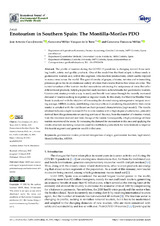Mostrar el registro sencillo del ítem
Enotourism in Southern Spain: The Montilla-Moriles PDO
| dc.contributor.author | Cava Jiménez, José Antonio | |
| dc.contributor.author | Millán Vázquez de la Torre, Genoveva | |
| dc.contributor.author | Dancausa Millán, Mª Genoveva | |
| dc.date.accessioned | 2022-03-14T13:06:09Z | |
| dc.date.available | 2022-03-14T13:06:09Z | |
| dc.date.issued | 2022 | |
| dc.identifier.uri | http://hdl.handle.net/10396/22689 | |
| dc.description.abstract | The profile of tourists during the COVID-19 pandemic is changing toward those seeking health, safety and quality products. One of the modalities that best adapts to these needs is gastronomic tourism and, within this segment, wine tourism (enotourism), which can be enjoyed in many areas across the world. The great diversity of grapes, climates, terrains and winemaking processes gives rise to an enormous variety of wines that ensures that no two wines are alike. The current situation of the tourism market necessitates enhancing the uniqueness of areas that offer differentiated products, helping to position such locations as benchmarks for gastronomic tourism. Gastronomic routes provide a way to unify and benefit rural areas through the recently increased demand of tourists seeking to experience regional foods. In this study, the Montilla-Moriles Wine Route is analyzed with the objective of forecasting the demand (using autoregressive integrate moving average, ARIMA models), establishing a tourist profile and calculating the probability that a wine tourist is satisfied with the visit based on their personal characteristics (logit model). The results obtained indicate a slight increase (3.6%) in wine tourists with a high degree of satisfaction, primarily derived from the gastronomic or catering services of the area, from the number of wineries visited, from the treatment received and from the age of the tourist. Consequently, a high percentage of these tourists recommend the route. By increasing the demand for enotourism in this area and applying the results obtained, marketing initiatives could be established, particularly for wine festivals to improve this tourist segment and generate wealth in that area. | es_ES |
| dc.format.mimetype | application/pdf | es_ES |
| dc.language.iso | eng | es_ES |
| dc.publisher | MDPI | es_ES |
| dc.rights | https://creativecommons.org/licenses/by/4.0/ | es_ES |
| dc.source | International Journal of Environmental Research and Public Health 19(6), 3393 (2022) | es_ES |
| dc.subject | Gastronomic routes | es_ES |
| dc.subject | Protected designation of origin | es_ES |
| dc.subject | Gastronomic tourism | es_ES |
| dc.subject | Logit model | es_ES |
| dc.subject | Montilla-Moriles | es_ES |
| dc.subject | ARIMA | es_ES |
| dc.title | Enotourism in Southern Spain: The Montilla-Moriles PDO | es_ES |
| dc.type | info:eu-repo/semantics/article | es_ES |
| dc.relation.publisherversion | https://doi.org/10.3390/ijerph19063393 | es_ES |
| dc.rights.accessRights | info:eu-repo/semantics/openAccess | es_ES |

